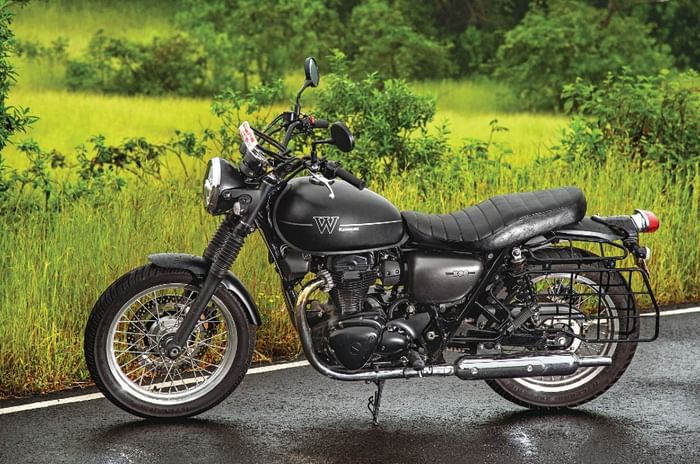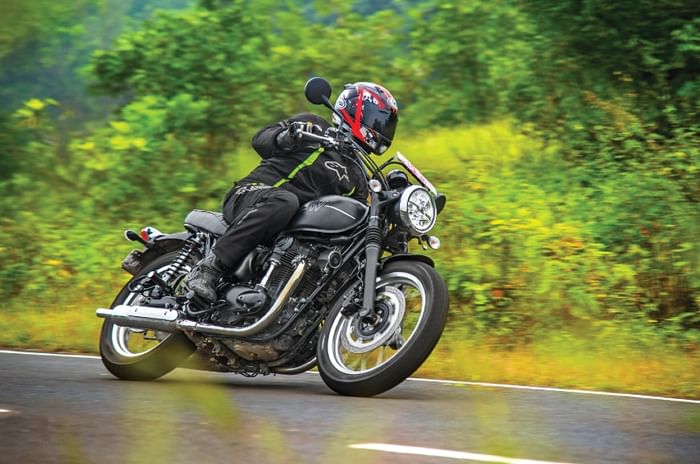This will come across as a statement that you may or may not agree with, but no matter how quick, sophisticated or enthralling modern motorcycles may become, they simply cannot match the charm and draw of a retro-themed motorcycle. I’ve come to this conclusion after spending two days with the BS6 Kawasaki W800. Allow me to explain.
W WHO?
For the longest time, most Indians have associated Kawasaki with the Ninja family of sports bikes. What many don’t know is that Kawasaki began making motorcycles in the 1960s and their first big-capacity machine was the 1966 W1. The W1, in turn, traces its lineage back to the BSA A7. While Google will tell you more about Kawasaki’s illustrious history, what you must note at this point is that the Kawasaki W800 pays homage to the W1. And we think it does so pretty well, especially with the way it looks.

AUTHENTIC RETRO
The moment you set your eyes on the Kawasaki W800, you are reminded of the old adage, ‘Keeping it simple’. There is no over-the-top razzmatazz that some manufacturers add to such motorcycles for them to grab attention. Instead, what you get is an elegant and minimal design that looks authentically retro, in every sense of the word.
Take the body panels, for instance. You have a large and shapely fuel tank that’s finished in matte black, a matte grey side panel, and well, that’s all the bodywork wrapped around the steel double-cradle chassis. The black metal fenders are neatly integrated, too, and the way the tail-lamp sticks out of the stubby rear fender is a nod to motorcycles from the ’60s and ’70s.
Adding a tiny touch of modernity to the appearance of the W800 is the blacked-out handlebar and engine that contrast beautifully with the chrome wire-spoke wheels and the pea-shooter exhaust pipes. However, the LED headlamp is an element that sticks out, considering how authentically retro the rest of the bike is. Case in point being the extremely basic switches on the metal switch cubes (there isn’t even a pass switch!), which seem to have been plucked straight off an old Kawasaki.

I also love the simple twin-pod analogue instrument cluster, with its classic fonts and theatre-style illumination. It houses all the warning lights within the pods and also has a small digital readout for the odometer, trip and time. What we would have also liked to see is a proper fuel gauge, instead of a panic-inducing low-fuel warning light.
Nevertheless, Kawasaki gets full marks for intent and execution, by coming up with a retro motorcycle design that looks the part.
The W800 is solidly put together as well, as any Japanese motorcycle ought to be. But park it next to its immediate competition, the Triumph Street Twin or even the pricier Triumph Bonneville T100, and the W800’s finish levels can’t match up, and the Triumphs also do a better job of hiding unsightly cables and hoses. And yes, the over-engineered saree guard and hair-band style number plate holder need to be chucked.
MORE THAN SKIN-DEEP
The W800’s lovely retro feel also permeates down from the design to the engine. This is another area where the W800 manages to add a dollop of creamy nostalgia to the experience, simply in the way it sounds and feels.
This 773cc, twin-cylinder unit is air cooled and features a shaft drive with bevelled gears for the SOHC, eight-valve head, just like some yesteryears motorcycles. Even the 360-degree crank, which means both pistons rise and fall together, is Kawasaki’s way of doing retro as it used to be done. And boy, are we glad that they did so! Because the overall result of such a setup is that the W800 sounds properly old school and reminiscent of the previous-gen Triumph Bonnevilles.

Thumb the tiny starter button and the exhaust note out of the pea shooters sounds markedly thrummy and distinct at idle. That soundtrack not only grows louder, but also sweeter, as the revs climb, which helps widen the smile under the helmet, despite the mildly underwhelming spec sheet.
The motor produces 52hp at 6,500rpm and 62.9Nm of torque at 4,800rpm, figures that may not seem exciting enough for a big twin. But in a classic case of not judging a book by its cover, our tests show that the W800 packs enough grunt for the real world. A 0-60kph sprint takes 2.84sec, while 100kph comes up in 6.12sec only. That’s properly quick for a 224kg motorcycle. Give it the beans and you will see the speedo needle easily meet with the 160-170kph mark on the dial, but that’s not the point of this motorcycle.
The beauty of riding the W800 is in a gentle cruise down the highway, with the gearbox slotted in fifth (the top cog). This is where the W800 is in its element, the accompanying exhaust note and a slight buzz in the handlebar and pegs adding to the sublime, old-world motorcycling experience. Come to think to it, there aren’t many modern-classic motorcycles around that offer a similar feeling, no?
In the city, the strong yet super-smooth torque delivery, well-spaced gear ratios and light lever action, courtesy of the slip-and-assist clutch, make this motorcycle a beauty to ride – even within Mumbai’s horrendous traffic. Surprisingly, the engine didn’t get uncomfortably hot in such situations, which again is an astonishing feat for an air-cooled mill of this size.
RIDES LIKE A CHARM
The basic double-cradle frame, 41mm telescopic fork and preload-adjustable twin shocks at the rear are a textbook classic motorcycle setup and it works well on the W800.
To begin with, the suspension settings are quite well judged and the ride is soft enough to absorb most bad roads without being wallowy over undulations. However, the low, 107mm rear suspension travel caused the shocks to bottom out over the nastiest of potholes. One will also have to be mindful of the 130mm ground clearance, but setting up the preload correctly, especially with a pillion onboard, will help you get through most of the rough stuff without scraping the belly.

On to the handling, we found that the W800 is neutral and predictable, a trait that many owners will appreciate. Despite the relaxed, 26-degree rake angle, the steering feels delightfully light and accurate, which makes it a breeze to manoeuvre the motorcycle through traffic. Around a series of bends, all one needs is a nudge on the pulled-back handlebar to make the front end tip into a corner, while the 1,465mm long wheelbase ensures solid mid-corner stability. Another factor that boosts confidence is the grippy MRF Zappers, be it on a wet or dry road. It doesn’t run out of cornering clearance as fast as a Harley-Davidson, but push it hard and you’ll be scraping the pegs all day long, especially on the right side, because it sticks out a little more.
The axially mounted Tokico front brake caliper offers decent bite but needs a firm pull on the lever. Calling on the rear brake at times helps make the motorcycle come to a halt in a jiffy. Good thing then that dual-channel ABS is standard.
FOR THE EXPERIENCE
Let’s address the elephant in the room, shall we? At Rs 6.99 lakh (ex-showroom, Delhi), some of you may find the Kawasaki W800 an expensive proposition, considering the paltry features list on offer. This despite Kawasaki slashing the price of the motorcycle by Rs 1 lakh as it stepped into the BS6 era.
A slightly deeper wallet will get you modern-classic motorcycles like the Triumph Street Twin (Rs 7.45 lakh) or the Triumph Bonneville T100 (Rs 8.89 lakh) (both prices, ex-showroom, Delhi). These offer well-known brand heritage, a more powerful liquid-cooled engine, traction control and higher levels of overall quality and finish.
But what the latest Bonnies can’t compete with is the genuine old-school experience that the W800 brings to the table. It truly offers a slice of nostalgia, be it in the way it looks, feels and rides. It’s not for everyone, but the fact that the W800 is probably so close to authentic retro that it certainly leaves a lasting impression.




































